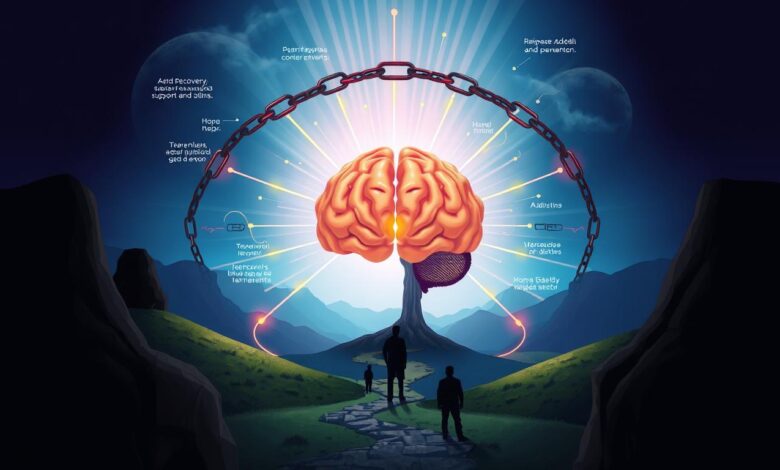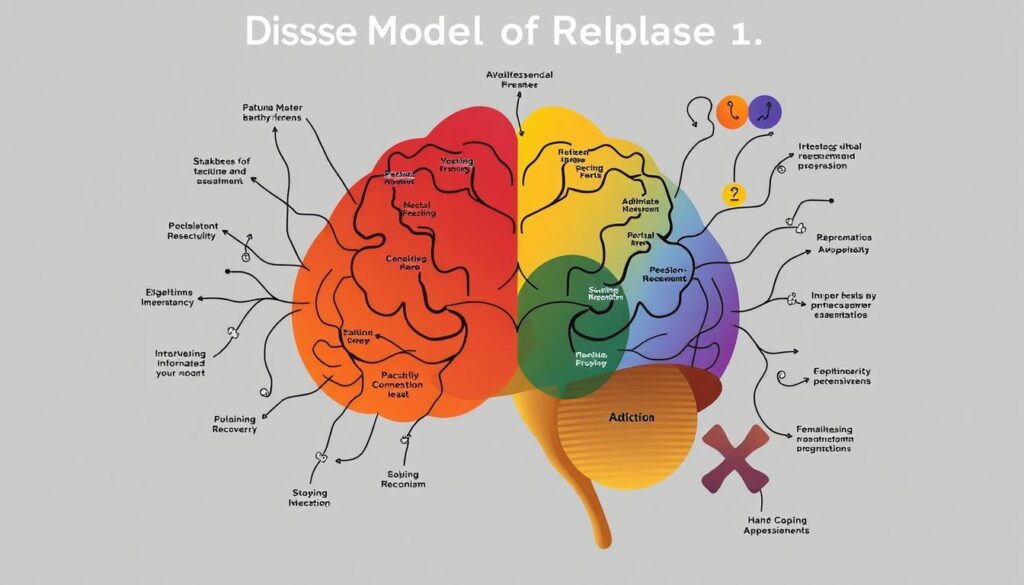disease model of relapse prevention

The disease model sees addiction as a chronic condition, like diabetes or heart disease. It’s not a choice or a moral failing. It’s a brain disease caused by biological, psychological, and social factors.
This model helps us understand why relapse happens. It shows that addiction is a serious issue. Knowing this can help us find better ways to prevent relapse.
Seeing addiction as a disease can also change how we view it. It reduces stigma and blame. This change can lead to more effective treatments. Treatments that focus on the whole person, not just the addiction.
Table of Contents
Understanding the Disease Model of Addiction
The disease model of addiction explains how the brain, behavior, and addiction are linked. It views addiction as a chronic disease, like diabetes or heart disease. This model changes the old view of addiction as a moral issue or lack of willpower. It sees addiction as a complex condition caused by changes in the brain.
Characteristics of Addiction as a Disease
Addiction has traits similar to chronic diseases, including:
- Irreversible brain changes: Addiction changes the brain’s structure and function, especially in reward, motivation, and memory areas. These changes make it hard to resist cravings and stay sober after addiction relapse.
- Compulsive behavior: People with addiction have a strong urge to seek and use substances or engage in addictive behaviors, even when it’s harmful.
- Genetic and environmental influences: Both genetic factors and environmental factors, like early life experiences and social environment, affect the development and progression of brain disease.
Key Components of the Disease Model
The disease model of addiction highlights several important points:
- It sees addiction as a chronic and progressive chronic disease, not as a moral failing or lack of willpower.
- It recognizes the compulsive nature of addictive behaviors and how hard it is for individuals to control substance use or addictive activities.
- It acknowledges the big role of genetic and environmental factors in the development and course of addiction.
Evolution of Addiction Treatment Approaches
The disease model of addiction has changed how we treat addiction. Modern treatments focus on the physical, psychological, and social aspects of addiction. This approach, which includes evidence-based therapies and long-term support, has shown to be more effective in managing addiction relapse and helping people stay in recovery.
The Neurobiology of Addiction and Recovery
Addiction changes the brain’s reward, motivation, and decision-making areas. The mesolimbic dopamine system is key, as substance use releases dopamine and causes imbalance.
The brain’s reward pathway is hijacked in addiction. This leads to cravings and withdrawal. The brain’s stress response is also disrupted. Knowing these changes helps in treating addiction.
Genetics play a big role in addiction, with a strong hereditary link. Teens are especially at risk because their brains are still developing. Starting substance use early can lead to more addiction and disorders.
Neuroimaging has helped us understand addiction better. It shows how addiction affects reward, control, stress, and learning. This knowledge helps in creating better treatments and supporting recovery.
| Key Neurobiological Mechanisms of Addiction | Impact on the Brain |
|---|---|
| Hijacking of the brain’s reward pathway | Dysregulation of the mesolimbic dopamine system, leading to persistent cravings and compulsive substance use |
| Impaired decision-making | Disruption of the prefrontal cortex, responsible for impulse control and rational decision-making |
| Disruption of the stress response system | Dysregulation of the brain’s stress circuits, leading to increased vulnerability to relapse during periods of stress or negative emotions |
Understanding brain changes, neurobiological mechanisms, and the recovery process is key. It helps in creating effective treatments and supporting those in recovery.
Disease Model of Relapse Prevention
The disease model sees addiction as a long-term issue that needs ongoing care. It views addiction as a brain disease that requires constant support to stay in recovery.
Core Principles of Prevention
The main ideas of the disease model of relapse prevention are:
- Seeing addiction as a chronic, relapsing brain disease
- Understanding the brain changes caused by addiction
- Using proven treatments and ongoing care
Identifying Risk Factors
The disease model stresses the need to find and tackle risk factors for relapse. These include:
- Genetic tendencies towards addiction
- Environmental factors like substance use or trauma
- Personal vulnerabilities, like mental health issues
Building Protective Factors
To prevent relapse, the disease model works on building protective factors. These are:
- Learning effective coping strategies
- Creating a supportive social network
- Dealing with any mental health conditions
By tackling risk factors and boosting protective factors, the disease model aims for long-term recovery. It helps people live a healthy, productive life.

“Addiction is a chronic, relapsing brain disease that is characterized by compulsive drug seeking and use, despite harmful consequences.” – National Institute on Drug Abuse
Brain Changes and Recovery Process
Recovery from addiction is a journey of brain healing and adaptation. The idea of neuroplasticity is key. It lets the brain make new connections and adjust without substances.
The recovery path has different stages, each with its own brain changes and hurdles:
- Withdrawal stage: At first, the brain tries to find balance without the addictive substance. Symptoms like cravings and mood swings show the brain’s effort to get back to normal.
- Early abstinence: As the person stays sober, the brain starts to heal and rewire. Cravings and symptoms lessen. This stage needs a lot of effort to create new, better neural paths.
- Protracted abstinence: Here, the brain keeps getting stronger against addiction triggers. Cravings might still happen, but the brain gets better at making good choices over time.
Knowing about these recovery stages is key for helping people. It shows how the brain can change and heal. This knowledge helps both healthcare teams and those in recovery to face challenges and achieve lasting recovery.
| Stage | Brain Changes | Challenges |
|---|---|---|
| Withdrawal | Struggling to regain balance, withdrawal symptoms | Cravings, mood disturbances |
| Early Abstinence | Healing and rewiring, reduced cravings | Establishing new, healthier neural pathways |
| Protracted Abstinence | Rebuilding resilience, improved impulse control | Ongoing management of cravings and triggers |
Understanding brain changes and recovery stages helps individuals tackle challenges. It aids in achieving lasting brain healing and recovery.
“Addiction is a brain disease, and it matters a great deal both for treatment and for public policy.” – Alan I. Leshner, former director of the National Institute on Drug Abuse
Genetic and Environmental Influences on Addiction
Addiction is a complex issue. It’s shaped by both genetic factors and the environment. Studies show that genetics play a big role, affecting about fifty percent of a person’s risk. Genetic variations can change how someone reacts to substances and how they feel rewarded.
The environment also matters a lot. Family history, where you live, and who you hang out with can all raise your risk. Early life experiences, like trauma or substance use, can also make you more likely to struggle with addiction later.
Hereditary Risk Factors
Genetics and epigenetics are being studied to find new ways to prevent and treat addiction. It’s found that some people are more likely to become addicted because of their genes. This is because their brains react differently to substances.
Impact of Social Environment
Your surroundings, especially when you’re young, can greatly affect your risk of addiction. Being around drugs, feeling pressure from friends, and taking risks can all lead to substance use. This can lead to a substance use disorder.
Role of Early Life Experiences
Childhood trauma, like abuse or losing a loved one, can also increase your risk. These experiences can change how your brain develops. This can make you more likely to turn to substances as a way to cope.
| Genetic Factors | Environmental Factors | Early Life Experiences |
|---|---|---|
| Genetic variations that influence substance response and reward sensitivity | Family history of drug use, exposure to high-risk environments, peer pressure | Trauma, abuse, neglect, early exposure to substances |
| Approximately 50% of addiction susceptibility is attributed to genetic factors | Access to drugs and high-risk activities can increase addiction risk | Stressful experiences can alter brain development and lead to substance use as a coping mechanism |
It’s important to understand how genetics, environment, and early life experiences work together. This knowledge helps us create better ways to prevent and treat addiction.
Managing Cravings and Triggers
Cravings and triggers are big hurdles in addiction recovery. The disease model of addiction shows that managing these urges is key to staying sober. Knowing how cravings work and finding ways to handle them can help keep sobriety on track.
Addiction changes the brain’s reward and motivation systems. Long-term substance use can alter brain paths, making cravings strong. These cravings can come from both inside and outside, like certain places or feelings.
- Finding out what triggers your cravings is a big first step.
- Using mindfulness and emotional control can help you deal with cravings without giving in.
- Medications for addiction can also help reduce cravings and aid in recovery.
Creating a solid plan to prevent relapse is crucial. This plan should cover cravings management and trigger identification. By understanding addiction and using proven relapse prevention strategies, people can stay on the path to recovery.
| Relapse Prevention Strategies | Effectiveness |
|---|---|
| Cognitive-Behavioral Techniques | Highly Effective |
| Medication-Assisted Treatments | Moderately Effective |
| Support System Engagement | Highly Effective |
| Lifestyle Modifications | Highly Effective |

“Cravings are the most common reason for relapse, but they can be managed with the right strategies and support. By understanding the science behind addiction, individuals can take proactive steps to maintain their recovery journey.”
Building Effective Support Systems
Recovering from addiction is a long journey. Having strong support systems is key to staying sober for a long time. The disease model of addiction shows how important it is to use many support networks to prevent relapse.
Professional Support Networks
Working with professionals like therapists and addiction specialists is very helpful. They offer guidance and treatments that work. They help create plans to avoid relapse, manage cravings, and deal with mental health issues.
Peer Support Groups
Being part of groups like Alcoholics Anonymous (AA) or Narcotics Anonymous (NA) is very powerful. It gives a sense of community and understanding. Sharing stories and struggles with others who get it can offer emotional support and help stay on track.
Family Involvement
Family support is a big help in recovery. Family therapy and education programs make a supportive home environment. They also teach family members how to spot and handle relapse signs.
Using many support systems helps build a strong safety net. This reduces the chance of relapse and boosts the chance of staying sober for a long time.
Developing Coping Strategies
Overcoming addiction is tough, but having good coping strategies can help a lot. The disease model of addiction shows that it changes how our brain works. So, it’s key to find and use healthy ways to cope.
Stress management is very important. The New York Office of Alcoholism and Substance Abuse Services (OASAS) says insomnia and fatigue can lead to relapse. Using deep breathing, mindfulness meditation, and grounding exercises can help manage stress and anxiety.
Learning to control your emotions is also crucial. A study by NCBI found that mindfulness meditation helps those in recovery. It reduces cravings and increases awareness and acceptance.
- Making a list of triggers can help you stay aware and avoid relapse.
- Joining a support group like Alcoholics Anonymous (AA) or Narcotics Anonymous (NA) offers support and education.
- Having a list of emergency contacts can provide support when you feel the urge to use.
- The “play the tape through” technique helps you think about the consequences of using, which can prevent relapse.
Learning coping skills is key to preventing relapse. By using stress management, emotional control, and other techniques, you can stay strong and recover for good.
| Coping Skill | Description | Benefits |
|---|---|---|
| Deep Breathing | The 4 x 4 technique, where you inhale for 4 seconds, hold for 4 seconds, and exhale for 4 seconds. | Releases neurotransmitters that trigger feel-good chemicals, resulting in relaxation, happiness, and pain reduction. |
| Mindfulness Meditation | A practice that focuses on the present moment, increasing awareness and acceptance. | Reduces cravings and helps individuals in recovery better manage urges and triggers. |
| Support Groups | Peer-based groups like AA or NA that provide support, accountability, and education. | Offers a sense of community, understanding, and the ability to learn from others’ experiences. |
Using different coping strategies can help you manage stress, control your emotions, and stay sober for a long time. Getting help from a treatment provider can also teach you more about preventing relapse.
Lifestyle Modifications for Sustainable Recovery
To recover from addiction, you need to make big changes in your life. Start by building healthy habits and learning to manage stress. These steps help you stay sober and feel good overall.
Healthy Routine Development
Getting enough sleep, eating well, and staying active are key. These actions help your body and mind heal. A steady routine gives you a sense of order and stability, which is important when you’re recovering.
Stress Management Techniques
Stress can lead to relapse, so managing it is crucial. Try meditation, deep breathing, or better time management. These methods help you deal with tough feelings and situations. They make you stronger against cravings and urges.
Self-Care Practices
Self-care is vital for your recovery and happiness. Enjoy hobbies, relax, and stay connected with friends. These activities help you find joy, purpose, and support. They make your life without addiction rich and fulfilling.
FAQ
What is the disease model of addiction?
The disease model sees addiction as a chronic brain disease. It causes people to seek drugs despite harm. It’s not a choice or moral failing but a neurological condition.
What are the key characteristics of the disease model of addiction?
Key traits include brain changes and addiction’s irreversible nature. Recovery means staying away from all addictive substances. Peer support is also vital.
How does the disease model explain the chronic nature of addiction?
It explains why addiction lasts and why relapses happen. It sees addiction as a chronic disease. It’s influenced by genetics and environment.
How has the treatment approach for addiction evolved based on the disease model?
Treatment now covers physical, psychological, and social aspects. The model stresses long-term management and support for recovery.
What are the neurobiological mechanisms involved in addiction?
Addiction changes brain areas for reward and control. The mesolimbic dopamine system is key. It’s about dopamine release and brain dysregulation.
What are the core principles of the disease model of relapse prevention?
It focuses on managing addiction’s chronic nature. It views addiction as a brain disease. It emphasizes ongoing care for recovery.
How does the disease model approach identifying risk factors for relapse?
It looks at genetics, environment, and individual vulnerabilities. Building protective factors includes coping skills and support systems.
What is the role of neuroplasticity in the recovery process?
Neuroplasticity helps the brain heal and adapt. It’s key for forming new connections and adapting to substance absence. It guides targeted support strategies.
What are the genetic and environmental factors that influence addiction?
Genetics play a big role, with half of the risk coming from them. Family history and environment also matter. Early life experiences, like trauma, increase addiction risk.
How does the disease model approach the management of cravings and triggers?
It’s about identifying and managing triggers. It views cravings as a neurobiological issue. This helps in understanding and addressing them in recovery.
What types of support systems are crucial in addiction recovery?
Support is key, including professional and peer groups. Family therapy and education are also important. They create a supportive environment.
How does the disease model approach the development of coping strategies?
It emphasizes learning stress and emotional control skills. It’s about managing addiction and preventing relapse. Healthy coping mechanisms are crucial.
What lifestyle modifications are important for sustainable recovery?
Recovery needs lifestyle changes. Healthy routines, stress management, and self-care are essential. They support long-term recovery and well-being.



